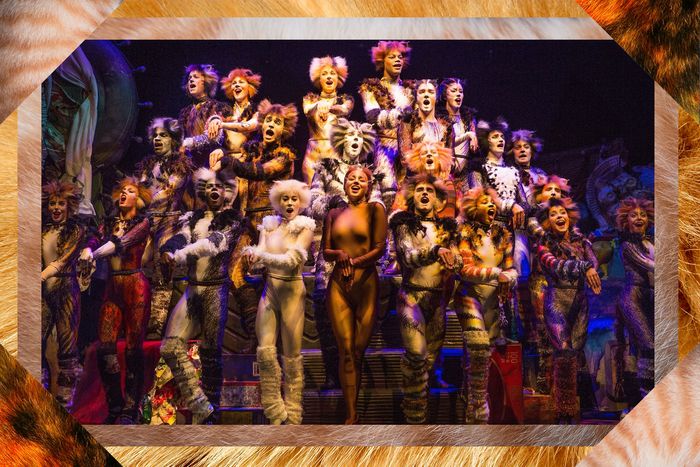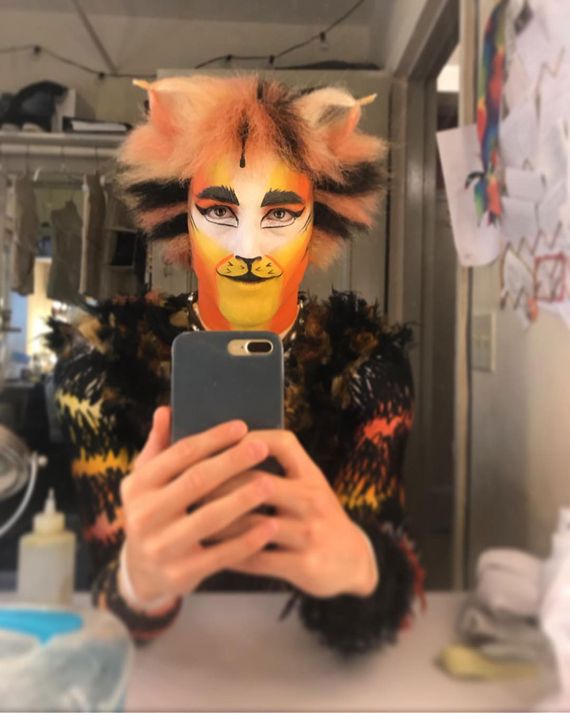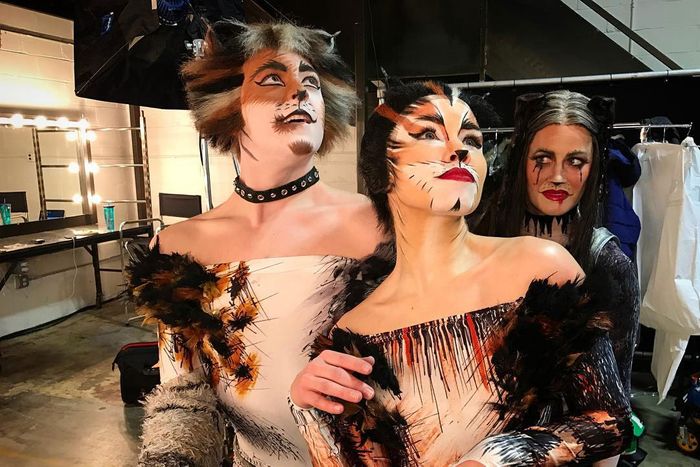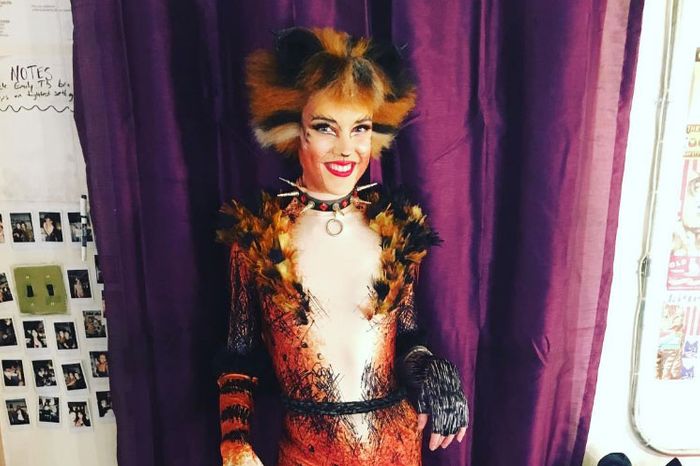
The thing about being in Cats is that you are a cat. Which sounds like, well, “duh,” but it does come with an interesting set of challenges not faced by cast members in shows that do not require them to be cats. For one, you look like a cat, which entails a full face of makeup, a furry wig, and a skin-tight leotard. For another, you have to act like a cat, which entails contorting your body nonstop for several hours and dancing as hard as you can. Vulture talked with three former cats from the 2016 Broadway revival to find whether or not it’s worth it. (Spoiler: Yes, obviously. It’s Cats.)
How many cats do you have to play in Cats?
Jonalyn Saxer: I’m a musical-theater dancer, but I never thought I would be hired to dance in Cats. I was hired very quickly, because another swing had gotten injured. So they needed somebody to take over her track as swinging, while she was on her medical leave. I found out I got the job the day after my audition. Originally, I was hired to cover three roles, the taller cats, really. Bombalurina, Demeter, and Cassandra. Then, once I had learned those three, more people were getting hurt or sick, and I ended up adding Tantomile, and Jennyanydots to my roster of cats.
Tanner Wilson: I made my Broadway debut with Cats when I was 24. They asked me to be Carbucketty to fill in for somebody who was having back surgery. I was so thrilled that afterwards they wanted me to stay on and be a swing. I was there for a year and a half total. I got to be a swing for almost an entire year … then I got to take over as the dance captain and close out the show.
Emily Tate: I actually did some preproduction work with [choreographer] Andy Blankenbuehler while I was auditioning for Cats. We were just working on choreography and creating material for the show. Then I had about a six- or eight-week audition process. I went in eight or nine times. It is definitely the most intense audition process I’ve had. When I got the show, we were in rehearsals for two months, and then the show ran for about 18 months. I was in it the whole time that it ran. I played Tantomile. I also understudied Victoria and Sillabub, who sings a little of “Memory.”
Saxer: The roles in Cats, it’s not like a typical ensemble. Every cat is very individual and has their own track, and their own different costume. It’s not like in Mean Girls [Saxer plays Karen in the touring company], [where] our swings cover eight girls, because they just wear normal clothes and they’re all doing the same choreography, just in different spots. Cats is very different. It’s more like understudying than swinging, really, when you think about it.
Wilson: I was a swing for Mr. Mistoffelees. It was always a minor panic attack when you found out you had to play that one as a swing. I covered Mungojerrie, which was my favorite. He got to sing a whole song and do cartwheels with Rumpelteazer. It was fantastic. And then I covered Alonzo, who was one of the older cats and a little bit snooty. He has some really fun moments. I covered Coricopat who, as you know, is a psychic cat with my twin sister, Tantomile. Then I was Pouncival and Tumblebrutus and Carbucketty again. I covered Carbucketty after I left the role.
I was often very frazzled and very trying to be focused as much as possible because there were seven different cats running through my head. You do have to check back in as a swing and check your notes, and prepare yourself mentally because you want to be able to have fun and get a good performance at the end of the day, and not think about not running into Jennyanydots or Grizabella. Or a giant trash can, or an oven, or a bra, or a Coke bottle.
How much training does it take to become a cat?
Tate: For the first four days of rehearsal, actually, we did not learn any choreography. We were working with Trevor Nunn and with Chrissie Cartwright. Chrissie had been working with Gillian [Lynne, the original choreographer] all these years and she sets a lot of companies of Cats around the world. Those first four days we were, basically, the entire cast on our hands and knees, just following cues from Trevor saying, “Find a place to snuggle up to or rub your back against.” “You just heard a loud sound over there, and how do you react?” And we were just all, for hours of the day for four days straight, just pretending to be cats. Like true acting class of cats.
What does Cats do to your body?
Tate: It was very taxing on my body. We did five-show weekends, and there’s no show harder to do five show weekends, I think. We had a lot of injuries in the cast. Having your body up to doing the show every day, it’s like zero to 60 in that opening number.
Saxer: In the Broadway revival, we did it like the original, where the stage was raked, so the stage had a slant to it. Not only were you doing all these crazy dance moves, and tumbling, and kicking, and crawling around, and sliding around, but you were doing it on a slanted stage.
Tate: It was like an inch per foot, so that’s a pretty steep rake.
Wilson: It’s a brutal schedule and you definitely climb hills with that show, you know what I mean? It’s hard mentally, it’s hard physically. For somebody who wants to be a cat, I would say just get your jazz dance techniques at a 10 and then go do some cardio at the gym.
How do you deal with the makeup?
Saxer: We had an incredible makeup supervisor named Victoria Tinsman. When people joined the show, you were scheduled for an hour-long makeup tutorial [with her], where she would give you all your brushes, and your paints, and your colors. The first one was always the hardest, because you have to learn everything. Okay, this is the muzzle, this is how you do the muzzle. Different cats had different types of cat eyes. She would go through, and drew, essentially, half your face, and you would do the other half of your face, to learn. There were some cats, like Tantomile, who had a very complicated makeup plot. The first time I went on for her, man, that looked terrible.
Tate: It took me about an hour and 15 minutes at the beginning to do my makeup. Because I haven’t ever done anything other than everyday makeup. But then by the end I got it down to about 45 minutes. My Tantomile makeup slab had more steps than some of the cats. So some of them were doing it in half an hour or so. But I don’t think anybody was doing it in less than half an hour. It was quite a process every day.
Wilson: You actually can’t leave the theater if you have your cat face on. Probably one of my favorite parts about a Saturday when we had two shows, was when we would all wipe the bottom half of our face off and eat our food and then we would spend like, the 30 minutes after that redoing just the bottom half of our face. We were like absolute monsters.
Saxer: I think the biggest shock so far was when the first commercial [for the new movie] came out, with all the CGI. We’re all just thinking, geez, nobody has black cat noses. We all had to have them. Every once in a while, on a day when you were a little sleepy, or you were running a little late, all of a sudden someone would look at you and they’re like, “You don’t have a nose!” To us, it looks very strange, because cats have little black noses. We were like, “Where are their noses?”
Tate: There were 13 girls in one dressing room. All the ensemble girls. It definitely took a solid 15 minutes for everyone to cycle through the sinks. We’d rub our face in coconut oil and everyone’s faces would just become this gray black mush. It definitely ruined many a towel, and I’ve got this hat that I wore after the show every day that is permanently stained.
Do the unitards smell?
Tate: They washed them every show. We were never going on in a dirty costume, but there’s a certain little level of musk that that doesn’t go away. When you’re sweating that much, and then rolling all over each other and the floor and just being covered in lots of people’s sweat. I think it was a petri dish for people getting sick.
Wilson: On a scale of one to ten, the answer is ten. You get incredibly sweaty. It’s something you just have to accept. The first time you do the show, you realize it and you make peace with you’re just going to be a swamp monster for the next year of your life. You learn to love your unitard. You get used to dancing in it. I’m not going to lie, post-cat life was a little weird, not having full body tights on. The next time I danced I was like, “Oh, I miss my little cozy little unitard.” It’s a love-hate relationship.
So is it all worth it? Is Cats a good Broadway gig?
Wilson: I had nothing but wonderful experiences with the cast, especially with the fans of the show because it has such a long-lasting journey and moment in theater history. To know that alone made it such a special show to be in. As a dancer, you really don’t get to dance like that on Broadway in a modern musical. So we always remembered that, and it made getting through the physical obstacle of the show possible.
Tate: And as a person who has been dancing since I could walk, it was the most fulfilling show I think I could do. I think it’s one of those anomalies [in theater] that is more fulfilling and satisfying maybe to be in, than even to watch. It’s more a gift for all the performers who got to do it and it’s wonderful to watch too, I’m not trying to cut it down, but it is really satisfying to be in it. I hope that another big dance musical comes and that there is that opportunity. But most Broadway shows are not crazy heavy dancing.
Saxer: If you talk to 20 Broadway performers, I guarantee at least 10 of them, especially dancers, decided to do musical theater because they watched the Cats movie, the live recording of the West End production, when they were younger. It has such a history.
Tate: It is a hard job. It definitely takes some work ethic and resilience and stamina. I think it was a mixed bag for the cast, who it was too hard for, too much, and not their passion, so wasn’t fulfilling in the same ways. That’s why some people stayed for six months and then went and did another show. But that was why I stayed the whole time. I loved that I got to dance so hard every day, as hard as it was.
Saxer: It’s also one of the most challenging shows that’s out there. It’s like, “Well, I did Cats, so I can really do anything.” Though you may not have facial recognition, as a principal or something, every cat has a little feature. Especially as dancers, we’re normally in ensemble, and we don’t always get that kind of moment. There was this one number, “Pekes and the Pollicles,” where, as Cassandra, I would wear this fake burlap sack over my head and burlap sacks on my hands and my feet. I felt so ridiculous, but I would be like, “I’m at the peak of my professional career. This show. Everybody wants to be in this show.”
More From This Series
- Cat Performances, Ranked
- Watch Cats With Us on Instagram Tonight … Please
- Cats Flopped and Then Things Got Interesting







